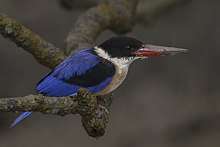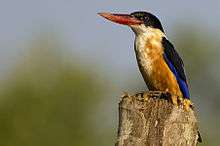Black-capped kingfisher
The black-capped kingfisher (Halcyon pileata) is a tree kingfisher which is widely distributed in tropical Asia from India east to China, Korea and Southeast Asia. This most northerly of the tree kingfishers is resident over much of its range, but northern populations are migratory, wintering south of their range in Sri Lanka, Thailand, Borneo and Java. It is distinctive in having a black cap that contrasts with the whitish throat, purple-blue wings and the coral red bill. The species is mainly found in coastal and mangrove habitats but can sometimes be found far inland.
| Black-capped kingfisher | |
|---|---|
 | |
| An adult Black-capped Kingfisher from Sundarban, West Bengal, India. | |
| Scientific classification | |
| Kingdom: | Animalia |
| Phylum: | Chordata |
| Class: | Aves |
| Order: | Coraciiformes |
| Family: | Alcedinidae |
| Subfamily: | Halcyoninae |
| Genus: | Halcyon |
| Species: | H. pileata |
| Binomial name | |
| Halcyon pileata (Boddaert, 1783) | |
Taxonomy
The black-capped kingfisher was described by the French polymath Georges-Louis Leclerc, Comte de Buffon in his Histoire Naturelle des Oiseaux in 1780.[2] The bird was also illustrated in a hand-coloured plate engraved by François-Nicolas Martinet in the Planches Enluminées D'Histoire Naturelle, which was produced under the supervision of Edme-Louis Daubenton to accompany Buffon's text.[3] Neither the plate caption nor Buffon's description included a scientific name, but in 1783 the Dutch naturalist Pieter Boddaert coined the binomial name Alcedo pileata in his catalogue of the Planches Enluminées.[4] The type locality is China.[5] The present genus Halcyon was introduced by the English naturalist and artist William John Swainson in 1821.[6] Halcyon is a name for a bird in Greek mythology generally associated with the kingfisher. The specific epithet pileata is from the Latin pileatus meaning '-capped'.[7] The species is monotypic.[8]
Description

This kingfisher is about 28 centimetres (11 in) long. The adult has purple-blue wings and back, black head and shoulders, white neck collar and throat, and rufous underparts. The large bill and legs are bright red. In flight, large white patches or "mirrors" at the base of the primaries are visible on the blue and black wings. Sexes are similar, but juveniles are a duller version of the adult and show streaks on the throat.[9] The call of this kingfisher is a cackling ki-ki-ki-ki-ki.
Usually seen on coastal waters and especially in mangroves, it is easily disturbed. It perches conspicuously and dives to catch fish, and also feeds on large insects. The flight of the black-capped kingfisher is rapid and direct, the short rounded wings whirring.
The breeding season is in summer. The nest is a tunnel in an earth bank. A single clutch of 4-5 round, white eggs is typical.[9]
A subspecies palawanensis has been described, but the species is considered to be monotypic with no clear plumage differences across its range.[5]
Distribution and habitat
The species is found mainly near the coast in mangrove forests and along estuaries and rivers. The distribution ranges from India (including the Andaman and Nicobar Islands where they occur even on remote islands like Narcondam[10]), Sri Lanka, Kansu, Shansi, Korea, Malay Peninsula, Thailand, Burma,[11] Ryukyu Islands, Hainan, Philippines (Palawan, Balabac, Basilan, Tawi Tawi), Borneo, Sumatra east to Sulawesi where it occurs only in winter.[5] Vagrants in winter have been recorded in Pakistan,[12] while movements related to rainfall may lead to their being found far inland and away from their usual distribution.[13][14][15][16][17]
In culture
Like many other kingfishers, this species was much sought for the blue feathers for their use in the millinery trade. Feathers were used in making fans in China.[17] In Hong Kong, their feathers were cut and glued over ornaments used by women.[18]
References
- BirdLife International (2012). "Halcyon pileata". IUCN Red List of Threatened Species. 2012. Retrieved 26 November 2013.CS1 maint: ref=harv (link)
- Buffon, Georges-Louis Leclerc de (1780). "Le martin-pêcheur à coiffe noir". Histoire Naturelle des Oiseaux (in French). Volume 13. Paris: De L'Imprimerie Royale. p. 278.
- Buffon, Georges-Louis Leclerc de; Martinet, François-Nicolas; Daubenton, Edme-Louis; Daubenton, Louis-Jean-Marie (1765–1783). Planches Enluminées D'Histoire Naturelle. Volume 7. Paris: De L'Imprimerie Royale. Plate 673, Martin-pêcheur de la Chine.
- Boddaert, Pieter (1783). Table des planches enluminéez d'histoire naturelle de M. D'Aubenton : avec les denominations de M.M. de Buffon, Brisson, Edwards, Linnaeus et Latham, precedé d'une notice des principaux ouvrages zoologiques enluminés (in French). Utrecht. p. 41 Number 673.
- Peters, James Lee, ed. (1945). Check-list of Birds of the World. Volume 5. Cambridge, Massachusetts: Harvard University Press. p. 197.
- Swainson, William John (1821). Zoological illustrations. Volume 1. London: Baldwin, Cradock, and Joy; and W. Wood. Plate 27 text.
- Jobling, James A. (2010). The Helm Dictionary of Scientific Bird Names. London: Christopher Helm. pp. 185, 306. ISBN 978-1-4081-2501-4.
- Gill, Frank; Donsker, David, eds. (2017). "Rollers, ground rollers & kingfishers". World Bird List Version 7.2. International Ornithologists' Union. Retrieved 7 November 2017.
- Baker, E.C. Stuart (1927). The Fauna of British India including Ceylon and Burma. Birds. Volume IV (2nd ed.). London: Taylor and Francis. pp. 271–272.
- Osmaston, B.B (1905). "A visit to Narcondam". J. Bombay Nat. Hist. Soc. 16 (4): 620–622.
- Oates, E.W. (1883). A handbook to the birds of British Burmah. Volume 2. London: R.H. Porter. p. 83.
- Kylanpaa, Juha (1998). "Black-capped Kingfisher Halcyon pileata: a new species for Pakistan" (PDF). Forktail. 13: 126.
- Stevens, H (1904). "The occurrence of the Black-capped Kingfisher Halcyon pileata in North Lakhimpur, Upper Assam". J. Bombay Nat. Hist. Soc. 16 (1): 154–155.
- Betts, F.N. (1957). "Halcyon pileata inland". J. Bombay Nat. Hist. Soc. 54 (2): 462.
- Allen, P.R. (1905). "Occurrence of the Black-capped Kingfisher Halcyon pileata in the Godavari Delta". J. Bombay Nat. Hist. Soc. 16 (3): 511.
- "Occurrence of the Blackcapped Kingfisher, Halcyon pileata (Boddaert) at Coimbatore, South India". J. Bombay Nat. Hist. Soc. 53 (4): 698. 1956.
- Sharpe, R. B. (1871). A monograph of the Alcedinidae: or family of Kingfishers. pp. 169–170.
- Swinhoe, R. (1860). "The ornithology of Amoy (China)". Ibis. 2 (1): 45–68. doi:10.1111/j.1474-919X.1860.tb06351.x.
